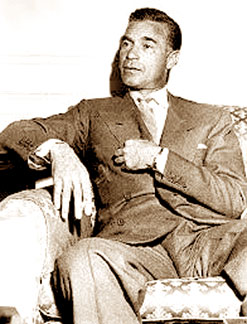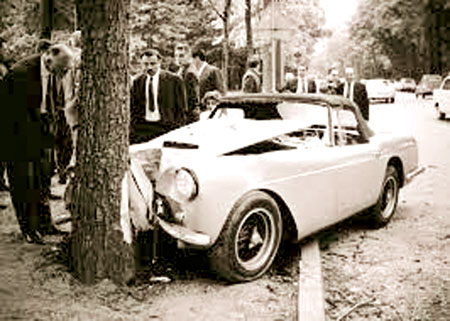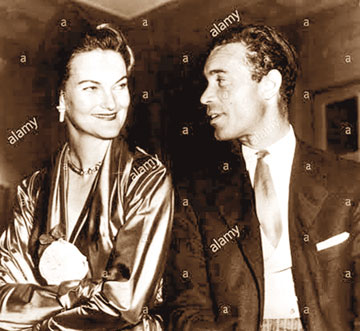|
Porfirio Rubirosa (1909 - 1965):
The Last Playboy
Shawn Levy was born in New York City, educated at the University of
Pennsylvania and the University of California. He was the film critic of
'The Oregonian' newspaper in Portland, Oregon from 1997-2012, and is a
former senior editor of 'American Film' and a former Associate Editor of
'Box Office'. He has contributed to several of North America's best
newspapers and has written biographies on Jerry Lewis (1996), The Rat
Pack (1998 and 2012), Swinging London (2002), Paul Newman (2009), Robert
de Niro (2014) and Dolce Vita Confidential (2016). However it is his
biography of Porfirio Rubirosa entitled 'The Last Playboy', published in
2005, which is perhaps his most revealing and sensational work.
PART II
 |
|
Porfirio Rubirosa |
On the afternoon of Wednesday 30 January 1953 Porfirio Rubirosa
married Barbara Hutton on Dominican soil in their New York Consulate.
Rafael Trujillo immediately reappointed Rubirosa to his diplomatic post
in Paris. She was granted Dominican citizenship by special decree, and
he received a lump sum of $2.5 million pursuant to a prenuptial
agreement. No less than 400 newspapermen attended the ceremony.
The combination of Rubirosa's quick wedding and his former lover's
black eye made for irresistible newspaper headlines. It was the bride's
fifth wedding and she looked frail and very much the worse for wear. She
was 41 years old, and even before their honeymoon in Palm Beach she fell
into her bath and broke her ankle. Once there they rented the Maharajah
of Baroda's Mansion on Ocean Drive with a full-time staff.
New wife
They kept separate quarters, hardly saw each other, and Rubirosa
continued playing polo, driving, night clubbing and shopping. His new
wife barely left her rooms - hobbling around and spending most of her
time in a wheel-chair. There was no sex. "How could I?" Rubirosa
obliquely comments, "She was on drugs." It was a disaster scenario and
one that couldn't last. One day in February 1954, only two months later,
Barbara Hutton packed her belongings and left the Ocean Drive mansion.
The marriage was over.
They had been married seventy-five days and the groom had come away
with $2.5 million in cash, a plantation in the Dominican Republic,
clothes, jewellery, a luxurious B25 aeroplane, plus many other
incidentals. By July 1955 under Dominican Law the marriage was
officially over, but the tragic life of Barbara Hutton continued.
There were two more marriages, her son's death in an air crash in
Aspen, Colorado, and an indolent life of financial mismanagement. When
she died at The Beverly Wilshire Hotel at sixty-seven she had a mere
$3,500 in cash and little else to show for her unhappy life.
Rubirosa
Rubirosa, in the years following, was linked with Dolores del Rio,
Eartha Kitt, Marilyn Monroe, Ava Gardner, Rita Hayworth, Joan Crawford,
Veronica Lake, Kim Novak, Judy Garland and Eva Peron. He was named
co-respondent in at least two divorce papers. He was wealthy and famous.
Then at the height of this fame and celebrity a new girl entered his
life. She was nineteen years old.
 |
|
Porfirio Rubirosa and fatal
car crash |
Odile Bérard (the acting world would later come to know her as Odile
Rodin) was a student at the Conservatoire National d'Art Dramatique -
with a wide smile, almond eyes, freckles, voluptuous curves and a chic
hair style. At a party after a polo match she met Rubirosa who
remembered her as being pretty "with a certain mystery in her gaze". He
proposed dinner - and then another night out.
Odile Rodin's mother objected strongly to the union saying to him, "Odile
is in the springtime of her life. You, on the other hand, are past your
prime." Rodin was given a much sought after role in the Marcel Pagnol
play 'Fabien' as an object of lust, which kept her in Paris while
Rubirosa followed the racing and polo seasons. During the summer however
they found themselves together again on the Riviera. She sought him out
in St. Jean-Cap-Ferrat arriving drenched in an already sheer summer
outfit.
Ten days in the South of France allowed the romance to blossom. She
was young and impressionable and he had the money, the cars, the
clothes, the house and the name. He in fact was a legend. Not long after
the opening of 'Fabien' in which she was a hit - Rodin moved out of her
family home and into his house on Rue de Bellechasse. On 27 October 1956
Rubirosa and Odile Rodin married in a quiet ceremony in Sonchamp - a
village thirty miles southwest of Paris. A small group of friends that
included Aly Khan and fashionista Genevieve Fath, and Count Guy
d'Arcangues attended the wedding. Odile, submitting to his convincing
arguments, gave up her acting career and followed Rubirosa to the
Dominican Republic for a honeymoon. He had plucked her from one stage
and was determined to groom her for another.
In 1958 Rubirosa was almost fifty years old. He looked good. He had
money in the bank, a beautiful young wife, lots of friends, fast cars,
horses, a lovely house and plenty of clothes. He was a recognised
celebrity and although he had no claim to the succession of Trujillo in
the Dominican Republic he was still a valuable asset. No Dominican had
better contacts in Europe or the United States.
Dominican Embassy
In September 1958 Rubirosa arrived in Havana and presented his
credentials as Ambassador to the government of Fulgencio Batista. It was
a crucial time in North American history and Trujillo counted on
Rubirosa to use his cunning and charm to make peace with both sides in
the simmering conflict.
 |
|
Doris duke and husband
Porfirio Rubirosa |
He was instructed to sell arms to Batista and to the rebels. Cannily,
Trujillo would only sell to the government for cash - but extended
credit to Castro. The Rubirosas' stay in Cuba wasn't long but it was
vivid. Odile was not only beautiful but the youngest ambassadress in the
world. They partied constantly in Havana - at that time perhaps the
wildest place in the world, and Rubirosa did meet Batista and
established useful relations between the two dictators.
On December 31 Rubirosa and Odile dined at the US Embassy and were
warned by Ambassador Earl Smith that something was going to happen. They
were going to have a problem.
Leaving the American Embassy they found themselves in a Havana under
siege. Rebel troops led by Che Guevara had entered the city. When they
reached the Dominican Embassy the telephone was already ringing and
Rubirosa was told to get to the US Embassy immediately as Batista had
left the country and landed in the Dominican Republic. This was a real
crisis. Rubirosa and his young wife were trapped in the US Embassy for a
week and then virtual prisoners in the Dominican Embassy for nearly four
months. They had no communication with the outside world and could not
leave the Embassy building - not until the Dominican Republic broke
relations with Cuba. Castro wanted Trujillo to turn Batista over to the
rebels - but Trujillo refused. The Dominican Embassy was bombed. By May
1959 the Rubirosas had left Cuba for good. One month after leaving
Havana Rubirosa was named Ambassador to Belgium.
Late in 1959 Rubirosa sold his house on Rue de Bellechasse in Paris
to the Rothschild family for an amount estimated to be half a million
dollars. With the money he bought a large house with a garden at 12 Rue
Schlumberger in Marnes-la-Coquette - a simple suburban village that had
been Maurice Chevalier's home. They had been married now for four years.
He was no longer racing cars and the couple mixed much more with
politicians, financiers and bluebloods rather than denizens of the night
in the dark alleys of the Left Bank. Friends noticed too that there
seemed to be friction between the couple and Rubirosa's "too young" wife
was growing to be a handful for him - preferring to be out and about and
showing an interest in some of his younger male friends. But he was
still Rubirosa, still playing polo, and still looking dark and
attractive with his wavy greying hair, quizzically arched eyebrows, and
irresistible wide smile.
In May 1961, while in Paris, the inevitable finally happened and
Trujillo was ambushed and killed in the Dominican Republic. On 2 January
1962 the seven-man Council of State for the Dominican Republic dismissed
Rubirosa from his post as Inspector of Embassies. After thirty years of
diplomatic pomp and immunity, Rubirosa's ambassadorial roles were
confiscated. He was a man without a job.
Back in Paris in 1963 Rubirosa found that his world had shrivelled
up. He stayed at home at night but continued to practice and play polo
during the days. "I like home life," he told a reporter. Odile, now in
her mid-twenties, found this retiring life far too dull - but she
admitted she was trapped in his world. Observers of their fast-moving
Paris set wondered openly about Rubirosa's ability to control his young
wife. They also noticed that, although he claimed to have an income of
$5,000 a month, he was clearly having a bad time making both ends meet.
He was running out of money. They reverted to selling off antiques and
works of art to pay for their lifestyle. Life was getting harder.
In July 1965 the annual Coupe de France polo tournament was held on
Rubirosa's home pitch - the Bagotelle in the Bois du Boulogne. Since the
mid 1950s his Cibao-La Pampa team had enjoyed particular success winning
it three years running, when he had seemingly unlimited finances to
produce a top-flight team. His new team in 1965 included two Frenchmen
and an Argentine. They played well, sporting red jerseys with a broad
white horizontal stripe across the breast.
La Calvados
The Cibao-La Pampa team surprisingly reached the final where they
facedLaversine - another Paris-based team whose captain was Baron Elie
de Rothschild. In a closely contested final Cibao-La Pampa won with a
score of 21/2 to 2. Rubirosa was thrilled with the victory and the good
discipline during the tournament called for a special celebration at New
Jimmys to mark the triumph. Both teams were there with wives, followers
and many admirers. Rubirosa and Odile arrived in separate cars - she in
an Austin, he in his specially charged Ferrari. They seemed strained
together but the party raged on until the early hours of the morning.
At 5.00 a.m. Odile left for home but Rubirosa, with his Argentine
polo friends, went on to La Calvados, a Spanish night-spot on the
Champs-Élysées. There, at 6.00 a.m. a party was already in progress and
the weary polo champions joined in. Approaching 7.00 a.m. the headwaiter
asked Rubirosa why he didn't go home. "I'm happy here," he answered.
"There's music, my beer, and I'm happy." But then suddenly Rubirosa left
At 8.00 a.m. on the Allée de la Reine Marguerite, two hundred yards
north of the Avenue de l'Hipodrome, Yves Ricourt, an engineer, was
reading his paper. A bicyclist approached the scene. Suddenly he heard a
metallic scrape behind him and turned to see a silver Ferrari with a
black convertible top hurtling towards him at high speed. Prudently he
veered his bicycle onto the bridle path away from the speeding car. He
didn't see the Ferrari crash into a chestnut tree head-on. Yves Ricourt
didn't hear the first sound but heard the second - a fearful crash. Both
Ricourt and the bicyclist raced to the wreck to see if they could help
the driver. The front end of the car was completely crumpled and the
hood forced back toward the passenger compartment. Inside was a gory
mess.
The driver hadn't been wearing a seat belt. He was crumpled over the
steering wheel - half of his scalp was torn away. He was moaning -
covered in glass. They dared not move him. Magically an ambulance
appeared on the scene and pried the wounded driver from the wreckage. He
was alive when they moved him but by the time they arrived at the
hospital, barely a mile away, it was too late.
Odile Rodin's last words to the press said it all: "It is better that
it happened this way. A clean break with the life he loved. Neither he
nor I could have endured the spectacle of him lingering on, a cripple,
unable to dance, play polo or drive his car. If Rubi could have chosen
the way he died this is the way he would have gone. In his car, in the
dawn, going fast as he loved to do. He loved speed. But he loved life
even more. .... I would have liked to be beside him, even in death."
Rubirosa's death made headlines all over the world - but it was all
over very quickly. Long good-byes had never been his trademark. His life
had been a whirlwind, a tidal wave, and then just as abruptly he
disappeared. His was a magical life. He will always be remembered as
'The Last Playboy'. |

